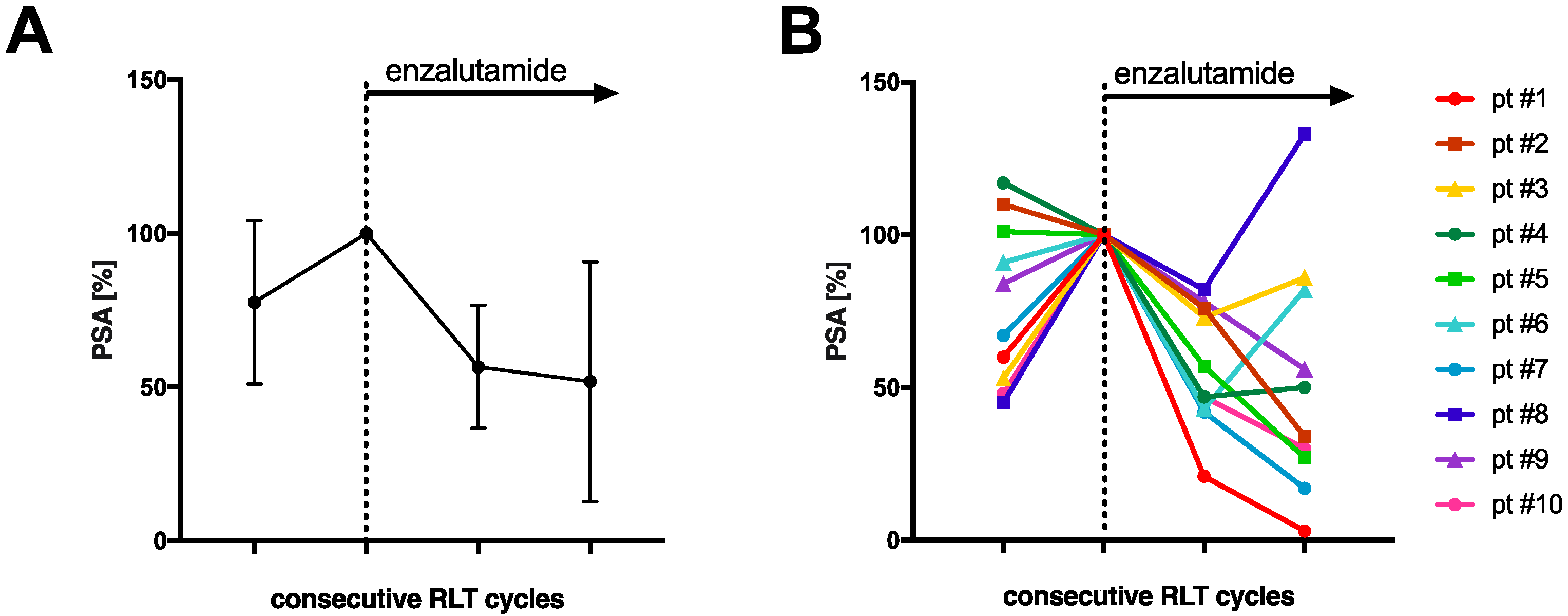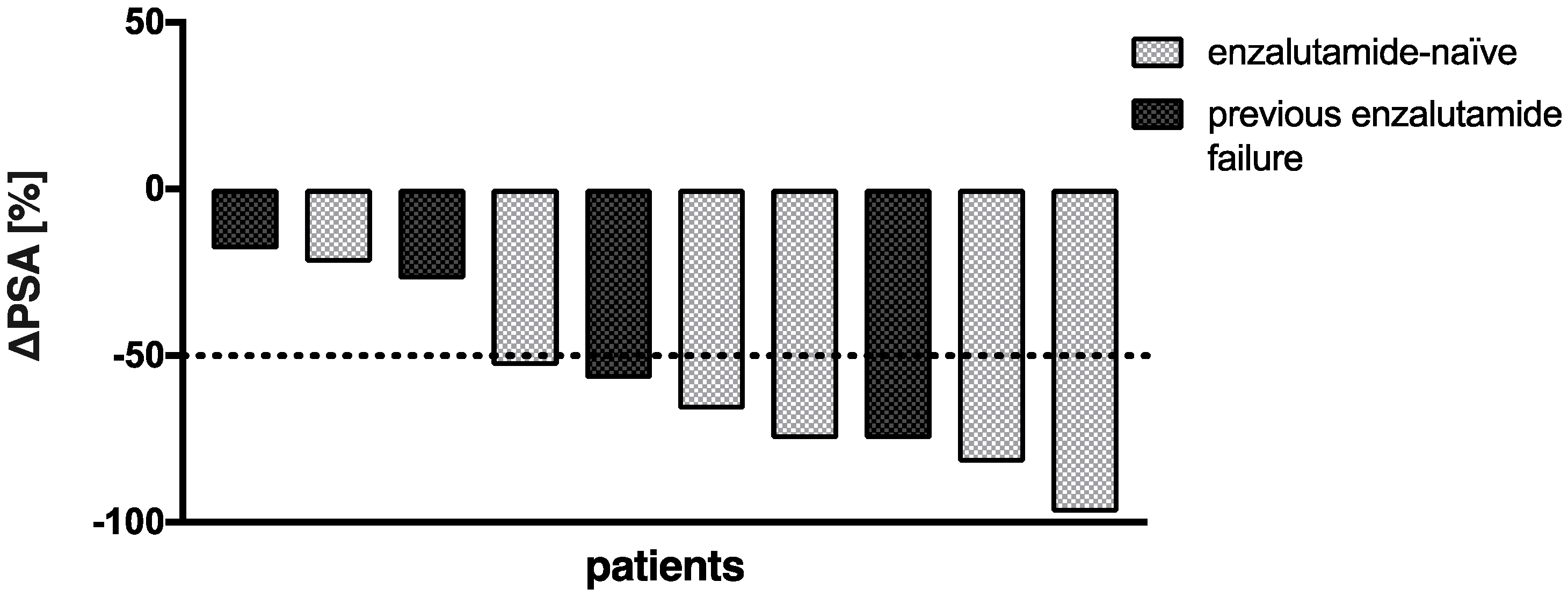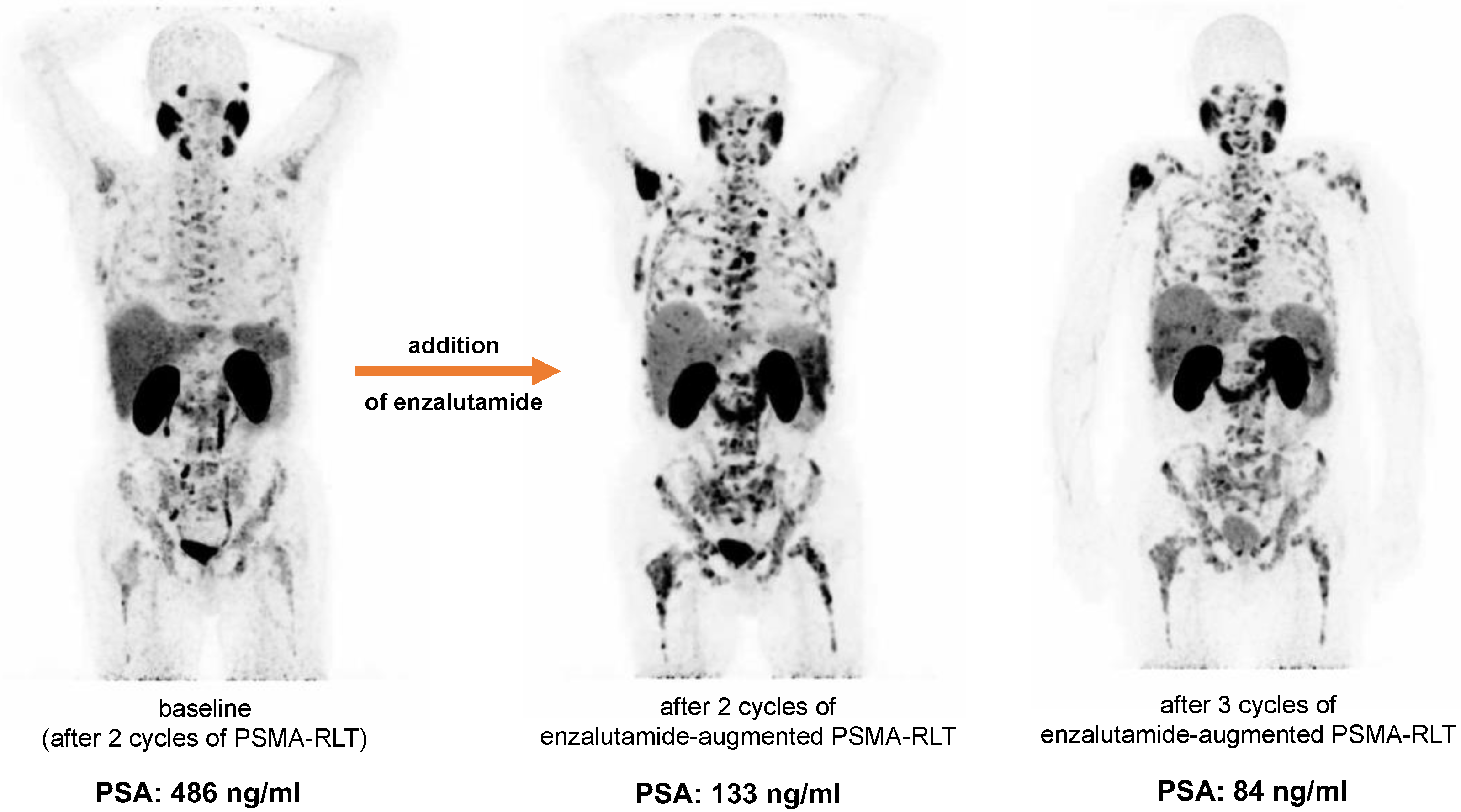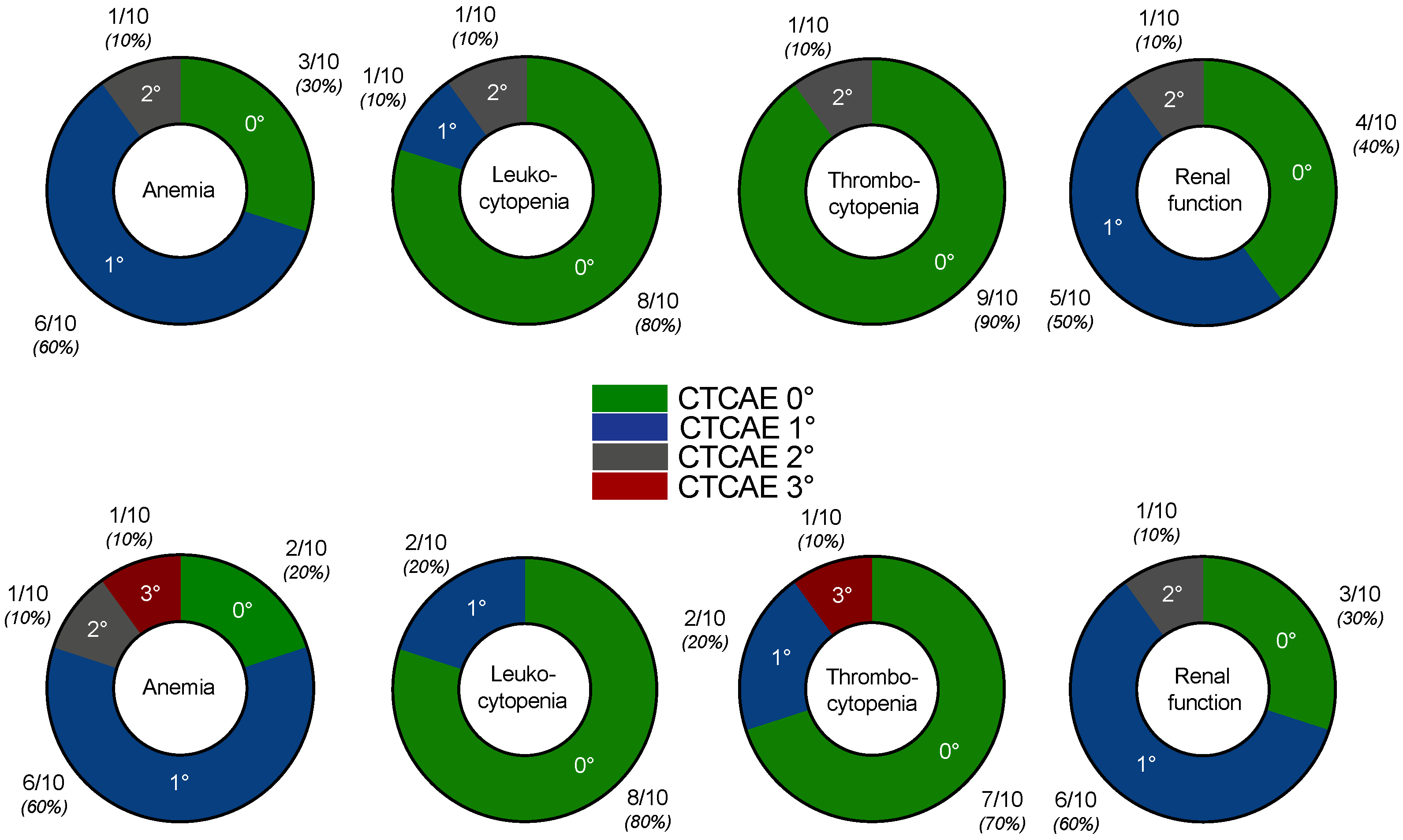Addition of Standard Enzalutamide Medication Shows Synergistic Effects on Response to [177Lu]Lu-PSMA-617 Radioligand Therapy in mCRPC Patients with Imminent Treatment Failure—Preliminary Evidence of Pilot Experience
Abstract
:Simple Summary
Abstract
1. Background
2. Methods
3. Results
4. Discussion
5. Conclusions
Author Contributions
Funding
Institutional Review Board Statement
Informed Consent Statement
Data Availability Statement
Conflicts of Interest
References
- Kirby, M.; Hirst, C.; Crawford, E.D. Characterising the Castration-Resistant Prostate Cancer Population: A Systematic Review: The Epidemiology of CRPC. Int. J. Clin. Pract. 2011, 65, 1180–1192. [Google Scholar] [CrossRef] [PubMed]
- Watson, P.A.; Arora, V.K.; Sawyers, C.L. Emerging Mechanisms of Resistance to Androgen Receptor Inhibitors in Prostate Cancer. Nat. Rev. Cancer 2015, 15, 701–711. [Google Scholar] [CrossRef] [PubMed] [Green Version]
- Rahbar, K.; Ahmadzadehfar, H.; Kratochwil, C.; Haberkorn, U.; Schäfers, M.; Essler, M.; Baum, R.P.; Kulkarni, H.R.; Schmidt, M.; Drzezga, A.; et al. German Multicenter Study Investigating 177Lu-PSMA-617 Radioligand Therapy in Advanced Prostate Cancer Patients. J. Nucl. Med. 2017, 58, 85–90. [Google Scholar] [CrossRef] [PubMed] [Green Version]
- Meyrick, D.; Gallyamov, M.; Sabarimurugan, S.; Falzone, N.; Lenzo, N. Real-World Data Analysis of Efficacy and Survival After Lutetium-177 Labelled PSMA Ligand Therapy in Metastatic Castration-Resistant Prostate Cancer. Target. Oncol. 2021, 16, 369–380. [Google Scholar] [CrossRef] [PubMed]
- Baum, R.P.; Kulkarni, H.R.; Schuchardt, C.; Singh, A.; Wirtz, M.; Wiessalla, S.; Schottelius, M.; Mueller, D.; Klette, I.; Wester, H.-J. 177Lu-Labeled Prostate-Specific Membrane Antigen Radioligand Therapy of Metastatic Castration-Resistant Prostate Cancer: Safety and Efficacy. J. Nucl. Med. 2016, 57, 1006–1013. [Google Scholar] [CrossRef] [PubMed] [Green Version]
- Hofman, M.S.; Violet, J.; Hicks, R.J.; Ferdinandus, J.; Thang, S.P.; Akhurst, T.; Iravani, A.; Kong, G.; Ravi Kumar, A.; Murphy, D.G.; et al. [177Lu]-PSMA-617 Radionuclide Treatment in Patients with Metastatic Castration-Resistant Prostate Cancer (LuPSMA Trial): A Single-Centre, Single-Arm, Phase 2 Study. Lancet Oncol. 2018, 19, 825–833. [Google Scholar] [CrossRef]
- Hofman, M.S.; Emmett, L.; Sandhu, S.; Iravani, A.; Joshua, A.M.; Goh, J.C.; Pattison, D.A.; Tan, T.H.; Kirkwood, I.D.; Ng, S.; et al. [177Lu]Lu-PSMA-617 versus Cabazitaxel in Patients with Metastatic Castration-Resistant Prostate Cancer (TheraP): A Randomised, Open-Label, Phase 2 Trial. Lancet 2021, 397, 797–804. [Google Scholar] [CrossRef]
- Sartor, O.; de Bono, J.; Chi, K.N.; Fizazi, K.; Herrmann, K.; Rahbar, K.; Tagawa, S.T.; Nordquist, L.T.; Vaishampayan, N.; El-Haddad, G.; et al. Lutetium-177-PSMA-617 for Metastatic Castration-Resistant Prostate Cancer. N. Engl. J. Med. 2021, 385, 1091–1103. [Google Scholar] [CrossRef]
- Scher, H.I.; Fizazi, K.; Saad, F.; Taplin, M.-E.; Sternberg, C.N.; Miller, K.; de Wit, R.; Mulders, P.; Chi, K.N.; Shore, N.D.; et al. Increased Survival with Enzalutamide in Prostate Cancer after Chemotherapy. N. Engl. J. Med. 2012, 367, 1187–1197. [Google Scholar] [CrossRef] [Green Version]
- Rosar, F.; Dewes, S.; Ries, M.; Schaefer, A.; Khreish, F.; Maus, S.; Bohnenberger, H.; Linxweiler, J.; Bartholomä, M.; Ohlmann, C.; et al. New Insights in the Paradigm of Upregulation of Tumoral PSMA Expression by Androgen Receptor Blockade: Enzalutamide Induces PSMA Upregulation in Castration-Resistant Prostate Cancer Even in Patients Having Previously Progressed on Enzalutamide. Eur. J. Nucl. Med. Mol. Imaging 2020, 47, 687–694. [Google Scholar] [CrossRef]
- Rosar, F.; Neher, R.; Burgard, C.; Linxweiler, J.; Schreckenberger, M.; Hoffmann, M.A.; Bartholomä, M.; Khreish, F.; Ezziddin, S. Upregulation of PSMA Expression by Enzalutamide in Patients with Advanced mCRPC. Cancers 2022, 14, 1696. [Google Scholar] [CrossRef]
- Common Terminology Criteria for Adverse Events (CTCAE) Version 5.0. Available online: https://ctep.cancer.gov/protocoldevelopment/electronic_applications/docs/ctcae_v5_quick_reference_5x7.pdf (accessed on 11 April 2022).
- Lückerath, K.; Wei, L.; Fendler, W.P.; Evans-Axelsson, S.; Stuparu, A.D.; Slavik, R.; Mona, C.E.; Calais, J.; Rettig, M.; Reiter, R.E.; et al. Preclinical Evaluation of PSMA Expression in Response to Androgen Receptor Blockade for Theranostics in Prostate Cancer. EJNMMI Res. 2018, 8, 96. [Google Scholar] [CrossRef] [PubMed]
- Hope, T.A.; Truillet, C.; Ehman, E.C.; Afshar-Oromieh, A.; Aggarwal, R.; Ryan, C.J.; Carroll, P.R.; Small, E.J.; Evans, M.J. 68Ga-PSMA-11 PET Imaging of Response to Androgen Receptor Inhibition: First Human Experience. J. Nucl. Med. 2017, 58, 81–84. [Google Scholar] [CrossRef] [PubMed] [Green Version]
- Meller, B.; Bremmer, F.; Sahlmann, C.O.; Hijazi, S.; Bouter, C.; Trojan, L.; Meller, J.; Thelen, P. Alterations in Androgen Deprivation Enhanced Prostate-Specific Membrane Antigen (PSMA) Expression in Prostate Cancer Cells as a Target for Diagnostics and Therapy. EJNMMI Res. 2015, 5, 66. [Google Scholar] [CrossRef] [PubMed]
- Kranzbühler, B.; Salemi, S.; Umbricht, C.A.; Müller, C.; Burger, I.A.; Sulser, T.; Eberli, D. Pharmacological Upregulation of Prostate-Specific Membrane Antigen (PSMA) Expression in Prostate Cancer Cells. Prostate 2018, 78, 758–765. [Google Scholar] [CrossRef] [PubMed]
- Murga, J.D.; Moorji, S.M.; Han, A.Q.; Magargal, W.W.; DiPippo, V.A.; Olson, W.C. Synergistic Co-Targeting of Prostate-Specific Membrane Antigen and Androgen Receptor in Prostate Cancer: Synergy Targets: PSMA and Androgen Receptor. Prostate 2015, 75, 242–254. [Google Scholar] [CrossRef] [PubMed]
- Staniszewska, M.; Fragoso Costa, P.; Eiber, M.; Klose, J.M.; Wosniack, J.; Reis, H.; Szarvas, T.; Hadaschik, B.; Lückerath, K.; Herrmann, K.; et al. Enzalutamide Enhances PSMA Expression of PSMA-Low Prostate Cancer. Int. J. Mol. Sci. 2021, 22, 7431. [Google Scholar] [CrossRef] [PubMed]
- Emmett, L.; Yin, C.; Crumbaker, M.; Hruby, G.; Kneebone, A.; Epstein, R.; Nguyen, Q.; Hickey, A.; Ihsheish, N.; O’Neill, G.; et al. Rapid Modulation of PSMA Expression by Androgen Deprivation: Serial 68Ga-PSMA-11 PET in Men with Hormone-Sensitive and Castrate-Resistant Prostate Cancer Commencing Androgen Blockade. J. Nucl. Med. 2019, 60, 950–954. [Google Scholar] [CrossRef] [PubMed] [Green Version]
- Aggarwal, R.; Wei, X.; Kim, W.; Small, E.J.; Ryan, C.J.; Carroll, P.; Cooperberg, M.; Evans, M.J.; Hope, T. Heterogeneous Flare in Prostate-Specific Membrane Antigen Positron Emission Tomography Tracer Uptake with Initiation of Androgen Pathway Blockade in Metastatic Prostate Cancer. Eur. Urol. Oncol. 2018, 1, 78–82. [Google Scholar] [CrossRef] [PubMed]




| Patient Characteristics | Value | |
|---|---|---|
| Age | ||
| Mean (range) in yrs. | 67 | (51–88) |
| ≥75 yrs.—n (%) | 3 | (30) |
| PSA | ||
| Mean (range) in ng/mL | 386 | (12–1156) |
| Sites of metastases—n (%) | ||
| Bone | 8 | (80) |
| Lymph node | 9 | (90) |
| Liver | 1 | (10) |
| Lung | 1 | (10) |
| Other | 1 | (10) |
| Prior treatments—n (%) | ||
| ADT | 10 | (100) |
| Abiraterone or Enzalutamide | 9 | (90) |
| Abiraterone | 8 | (80) |
| Enzalutamide | 4 | (40) |
| Docetaxel or Cabazitaxel | 10 | (100) |
| Docetaxel | 10 | (100) |
| Cabazitaxel | 6 | (60) |
| 223Ra | 1 | (10) |
| PSMA-RLT before addition of enzalutamide | ||
| Cycles—median (range) | 2 | (1–3) |
| Cum. Activity—median (range) in GBq | 10.8 | (5.5–17.5) |
Publisher’s Note: MDPI stays neutral with regard to jurisdictional claims in published maps and institutional affiliations. |
© 2022 by the authors. Licensee MDPI, Basel, Switzerland. This article is an open access article distributed under the terms and conditions of the Creative Commons Attribution (CC BY) license (https://creativecommons.org/licenses/by/4.0/).
Share and Cite
Rosar, F.; Bader, H.; Bartholomä, M.; Maus, S.; Burgard, C.; Linxweiler, J.; Khreish, F.; Ezziddin, S. Addition of Standard Enzalutamide Medication Shows Synergistic Effects on Response to [177Lu]Lu-PSMA-617 Radioligand Therapy in mCRPC Patients with Imminent Treatment Failure—Preliminary Evidence of Pilot Experience. Cancers 2022, 14, 2691. https://doi.org/10.3390/cancers14112691
Rosar F, Bader H, Bartholomä M, Maus S, Burgard C, Linxweiler J, Khreish F, Ezziddin S. Addition of Standard Enzalutamide Medication Shows Synergistic Effects on Response to [177Lu]Lu-PSMA-617 Radioligand Therapy in mCRPC Patients with Imminent Treatment Failure—Preliminary Evidence of Pilot Experience. Cancers. 2022; 14(11):2691. https://doi.org/10.3390/cancers14112691
Chicago/Turabian StyleRosar, Florian, Hanna Bader, Mark Bartholomä, Stephan Maus, Caroline Burgard, Johannes Linxweiler, Fadi Khreish, and Samer Ezziddin. 2022. "Addition of Standard Enzalutamide Medication Shows Synergistic Effects on Response to [177Lu]Lu-PSMA-617 Radioligand Therapy in mCRPC Patients with Imminent Treatment Failure—Preliminary Evidence of Pilot Experience" Cancers 14, no. 11: 2691. https://doi.org/10.3390/cancers14112691
APA StyleRosar, F., Bader, H., Bartholomä, M., Maus, S., Burgard, C., Linxweiler, J., Khreish, F., & Ezziddin, S. (2022). Addition of Standard Enzalutamide Medication Shows Synergistic Effects on Response to [177Lu]Lu-PSMA-617 Radioligand Therapy in mCRPC Patients with Imminent Treatment Failure—Preliminary Evidence of Pilot Experience. Cancers, 14(11), 2691. https://doi.org/10.3390/cancers14112691







